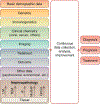Artificial intelligence and machine learning in nephropathology
- PMID: 32475607
- PMCID: PMC8906056
- DOI: 10.1016/j.kint.2020.02.027
Artificial intelligence and machine learning in nephropathology
Abstract
Artificial intelligence (AI) for the purpose of this review is an umbrella term for technologies emulating a nephropathologist's ability to extract information on diagnosis, prognosis, and therapy responsiveness from native or transplant kidney biopsies. Although AI can be used to analyze a wide variety of biopsy-related data, this review focuses on whole slide images traditionally used in nephropathology. AI applications in nephropathology have recently become available through several advancing technologies, including (i) widespread introduction of glass slide scanners, (ii) data servers in pathology departments worldwide, and (iii) through greatly improved computer hardware to enable AI training. In this review, we explain how AI can enhance the reproducibility of nephropathology results for certain parameters in the context of precision medicine using advanced architectures, such as convolutional neural networks, that are currently the state of the art in machine learning software for this task. Because AI applications in nephropathology are still in their infancy, we show the power and potential of AI applications mostly in the example of oncopathology. Moreover, we discuss the technological obstacles as well as the current stakeholder and regulatory concerns about developing AI applications in nephropathology from the perspective of nephropathologists and the wider nephrology community. We expect the gradual introduction of these technologies into routine diagnostics and research for selective tasks, suggesting that this technology will enhance the performance of nephropathologists rather than making them redundant.
Keywords: artificial intelligence; computer; convolutional neural network; image recognition; nephropathology.
Copyright © 2020 International Society of Nephrology. All rights reserved.
Figures



References
-
- De Heer E, Sijpkens YW, Verkade M, et al. Morphometry of interstitial fibrosis. Nephrol Dial Transplant. 2000;15(suppl 6):72–73. - PubMed
-
- Pape L, Henne T, Offner G, et al. Computer-assisted quantification of fibrosis in chronic allograft nephropathy by picosirius red-staining: a new tool for predicting long-term graft function. Transplantation. 2003;76: 955–958. - PubMed
-
- Babickova J, Klinkhammer BM, Buhl EM, et al. Regardless of etiology, progressive renal disease causes ultrastructural and functional alterations of peritubular capillaries. Kidney Int. 2017;91:70–85. - PubMed
Publication types
MeSH terms
Grants and funding
LinkOut - more resources
Full Text Sources
Medical

